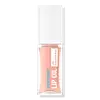What's inside
What's inside
 Key Ingredients
Key Ingredients

 Benefits
Benefits

 Concerns
Concerns

No concerns
 Ingredients Side-by-side
Ingredients Side-by-side

Polyisobutene
Octyldodecanol
EmollientHydrogenated Polyisobutene
EmollientPolyglyceryl-2 Triisostearate
EmulsifyingSorbitan Isostearate
EmulsifyingHydrogenated Styrene/Isoprene Copolymer
Phenoxyethanol
PreservativeTocopheryl Acetate
AntioxidantEthylhexyl Palmitate
EmollientParfum
MaskingPrunus Amygdalus Dulcis Oil
Skin ConditioningSimmondsia Chinensis Seed Oil
EmollientCamellia Japonica Seed Oil
EmollientEthylhexylglycerin
Skin ConditioningBis-Diglyceryl Polyacyladipate-2
EmollientButyrospermum Parkii Butter
Skin ConditioningLimnanthes Alba Seed Oil
Skin ConditioningSodium Hyaluronate
HumectantHydrogenated Castor Oil
EmollientTocopherol
AntioxidantCI 77891
Cosmetic ColorantCI 15850
Cosmetic ColorantCI 42090
Cosmetic ColorantPolyisobutene, Octyldodecanol, Hydrogenated Polyisobutene, Polyglyceryl-2 Triisostearate, Sorbitan Isostearate, Hydrogenated Styrene/Isoprene Copolymer, Phenoxyethanol, Tocopheryl Acetate, Ethylhexyl Palmitate, Parfum, Prunus Amygdalus Dulcis Oil, Simmondsia Chinensis Seed Oil, Camellia Japonica Seed Oil, Ethylhexylglycerin, Bis-Diglyceryl Polyacyladipate-2, Butyrospermum Parkii Butter, Limnanthes Alba Seed Oil, Sodium Hyaluronate, Hydrogenated Castor Oil, Tocopherol, CI 77891, CI 15850, CI 42090
Polybutene
Diisostearyl Malate
EmollientTridecyl Trimellitate
EmollientHydrogenated Polyisobutene
EmollientOctyldodecanol
EmollientSilica Dimethyl Silylate
EmollientVp/Hexadecene Copolymer
Sorbitan Isostearate
EmulsifyingSimmondsia Chinensis Seed Oil
EmollientTocopheryl Acetate
AntioxidantHydrolyzed Hyaluronic Acid
HumectantDehydroacetic Acid
PreservativeVanillyl Butyl Ether
MaskingPolyglyceryl-2 Triisostearate
EmulsifyingPolyglyceryl-2 Diisostearate
EmulsifyingTitanium Dioxide
Cosmetic ColorantIron Oxides
CI 15850
Cosmetic ColorantPolybutene, Diisostearyl Malate, Tridecyl Trimellitate, Hydrogenated Polyisobutene, Octyldodecanol, Silica Dimethyl Silylate, Vp/Hexadecene Copolymer, Sorbitan Isostearate, Simmondsia Chinensis Seed Oil, Tocopheryl Acetate, Hydrolyzed Hyaluronic Acid, Dehydroacetic Acid, Vanillyl Butyl Ether, Polyglyceryl-2 Triisostearate, Polyglyceryl-2 Diisostearate, Titanium Dioxide, Iron Oxides, CI 15850
 Reviews
Reviews

Ingredients Explained
These ingredients are found in both products.
Ingredients higher up in an ingredient list are typically present in a larger amount.
Ci 15850 is the pigment color red. It is an azo dye and created synthetically.
Azo dyes need to be thoroughly purified before use. This allows them to be more stable and longer-lasting.
This ingredient is common in foundations, lipsticks, and blushes. This color is described as brown/orangey red.
It has many secondary names such as Red 6 and Red 7. According to a manufacturer, Red 6 usually contains aluminum.
Learn more about CI 15850Hydrogenated Polyisobutene is a synthetic polymer. Polymers are compounds with high molecular weight. Hydrogenated Polyisobutene is an emollient and texture enhancer.
In one study, Hydrogenated Polyisobutene showed better skin hydration levels than Caprylic/Capric Triglyceride. As an emollient, it helps keep your skin soft and hydrated by trapping moisture in.
Hydrogenated Polyisobutene is often used as a mineral oil replacement.
Learn more about Hydrogenated PolyisobuteneOctyldodecanol is a fatty alcohol. It is primarily used to enhance the texture of products.
As an emulsifier, Octyldodecanol helps prevent the oils and waters from separating. It also prevents ingredients from creating foam when shaken.
Octyldodecanol is created by reducing fatty acid to an alcohol.
Due to its high molecular weight, it does not get absorbed into the skin.
Learn more about OctyldodecanolThis ingredient is a form of glycerin with emulsifying and emollient properties.
As an emulsifier, this ingredient helps keep products together while adding a thick texture. The manufacturer states this ingredient has emollient properties. Emollients help keep the skin hydrated by trapping moisture in.
Polyglyceryl-2 Triisostearate is created by reacting diglycerin and isostearic acid. Due to the isostearic acid base, it may not be safe for Malassezia or fungal acne.
Learn more about Polyglyceryl-2 TriisostearateThis oil comes from the seeds of the desert shrub called Jojoba. It is more commonly known as jojoba oil, a non-comedogenic oil.
Jojoba oil does not contain fragrance and has many fatty-acids, making it a great soothing ingredient.
It also contains Vitamin E, a great moisturizing ingredient. Vitamin E is also an antioxidant and protects your skin against oxidative damage.
This ingredient humectant properties, meaning it helps draw moisture from the air. This helps keep your skin hydrated.
While jojoba has antibacterial properties, it is only able to kill some strains of bacteria.
Studies also show it helps in wound healing. In fact, Indigenous cultures have used jojoba as a moisturizer and to help treat burns for centuries.
Fun fact: Jojoba oil similar to natural human skin sebum, so it has a great effect on dry skin. It is also promising with helping to regulate sebum production.
Due to its fatty acid content, Jojoba oil may not be fungal acne safe. We recommend speaking with a professional if you have any concerns.
Learn more about Simmondsia Chinensis Seed OilSorbitan Isostearate is an emulsifer and cleaning agent. It is created from isostearic acid and sorbitol.
As an emulsifier, Sorbitan Isostearate prevents oils and water from separating.
Due to its isostearic acid base, it may not be safe for Malassezia or fungal acne.
Learn more about Sorbitan IsostearateTocopheryl Acetate is AKA Vitamin E. It is an antioxidant and protects your skin from free radicals. Free radicals damage the skin by breaking down collagen.
One study found using Tocopheryl Acetate with Vitamin C decreased the number of sunburned cells.
Tocopheryl Acetate is commonly found in both skincare and dietary supplements.
Learn more about Tocopheryl Acetate